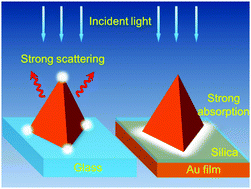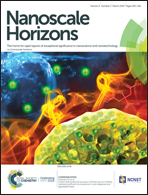Converting plasmonic light scattering to confined light absorption and creating plexcitons by coupling a gold nano-pyramid array onto a silica–gold film†
Abstract
This report presents a facile microfabrication-compatible approach to fabricate a large area of plasmonic nano-pyramid array-based antennas and demonstrates effective light management by tailoring the architecture. First, a long-range ordered gold nano-pyramid array is fabricated, which exhibits strong light scattering. The maximum electric field enhancement (|E|/|E0|) of 271 is achieved at the corner but decays rapidly away from the pyramid bottom. After the gold nanopyramid array is coupled to a gold film, strong light scattering is converted into strong light absorption due to the excitation of a spectrally tunable plasmonic gap mode, where an intense electric field enhancement of 233 and a strong magnetic field enhancement (|H|/|H0|) of 25 are simultaneously excited for a 10 nm silica gap. The electric field decays much slower away from the pyramid bottom while the magnetic field keeps almost constant. In addition, both experiments and finite-difference time-domain (FDTD) simulations have confirmed that strong plasmon–exciton coupling between the plasmonic gap mode and the J-aggregates can take place when quantum emitters such as J-aggregates are embedded in the gap, creating plexcitons. This can overcome the problems of high energy loss and weak nonlinearity, which are typically associated with surface plasmon polaritons (SPPs) supported on plasmonic metallic nanostructures. The coherent plasmon–exciton coupling (plexciton) generated by the film-coupled nano-pyramid nanostructure is expected to find promising applications in light-emitting devices, photodetectors, photovoltaics and photoelectrochemical cells.



 Please wait while we load your content...
Please wait while we load your content...